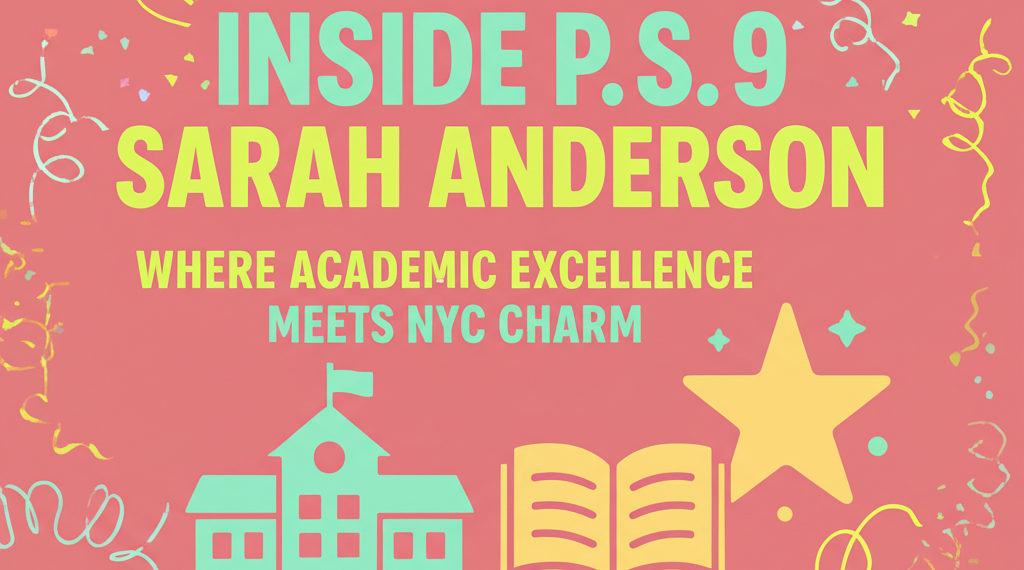Inside P.S. 9 Sarah Anderson: Where Academic Excellence Meets NYC Charm
Smart, Spirited, and Pure Upper West Side

Hey friends and fellow parent-researchers!
If you're anything like me—maybe you've just moved to the Upper West Side or you're deep into your annual ritual of school-stalking (totally normal, right?)—you've probably heard a thing or two about P.S. 9 Sarah Anderson. This Manhattan public elementary school has been getting a ton of attention lately, and I decided to do a full-on deep dive to find out: Is the hype real?
Spoiler: mostly yes. But there’s more to the story. So buckle up and let me walk you through what I’ve learned.
Where is P.S. 9 and Who Goes There?
First off, P.S. 9 is nestled right in the heart of the Upper West Side at 100 W 84th Street. It's a Pre-K through 5th grade school that also provides special education services and shares its building with The Center School (a middle school). The vibe? Urban, friendly, community-focused.
Now here’s where it gets interesting—demographically, P.S. 9 is not your average NYC public school. Around 60% of students are White, and the percentage of economically disadvantaged students is notably lower than the city average (about 14–19%, compared to NYC’s 74% citywide). It’s also got a pretty balanced gender split and a relatively small English Language Learner population.
Translation: It’s a neighborhood school serving a more affluent and less linguistically diverse population than many others in NYC.
How’s the Academics?
In a word? Impressive.
Let’s talk numbers. According to the 2022–23 state assessments:
- 83% of students scored proficient in English Language Arts (ELA).
- 86% scored proficient in Math.
These are not just decent—they’re stellar, especially when compared to the citywide average (around 50% for ELA and 53% for Math). In Grade 3 Math, the school hit an eyebrow-raising 90% proficiency rate.
It’s no wonder they earned a National Blue Ribbon School award in 2023. That’s like the Oscars of education. The award recognized their killer strategies like blending social studies with literacy and using small-group teaching to meet kids where they’re at.
But What About Equity?
Now here’s where it gets complicated.
While the school crushes it on academic achievement, there are clear gaps when you zoom in on subgroups. Students with disabilities do way better here than at most other city schools—but they still lag significantly behind their general ed peers. And English Language Learners (ELLs)? Let’s just say… there’s a lot of room for growth. Some data even showed 0% proficiency in certain subjects/grades for ELLs. Yikes.
Same goes for economically disadvantaged kids and some racial/ethnic subgroups. The school says every child will succeed, but these numbers show that some kids are still being left behind.
What Are Parents and Teachers Saying?
So, how does this data translate to day-to-day life? According to surveys:
- 100% of teachers said they’d recommend P.S. 9 to others.
- 98% of parents said they’re satisfied.
- 97% of families feel welcomed.
That’s pretty much as good as it gets. Parents rave about the leadership, the teachers (seriously, there are glowing reviews calling them “extraordinary”), and the sense of community. There’s also a super active Parent Association that organizes events, raises money, and helps keep the good vibes flowing.
That said, not everything is rainbows and jazz hands. A few parents mentioned lackluster responses to bullying incidents, communication issues with specific staff, and some frustrations over big class sizes or resources like classroom assistants being underutilized. These seem to be the exception, but worth noting.
So, What’s Special About P.S. 9?
A lot, actually.
Let me just list a few things that made me go “WOW”:
- Carnegie Hall partnership – kids get to participate in an orchestra program!
- NYC Ballet partnership – yes, they actually integrate dance into the curriculum.
- Robotics + Tech – there’s a LEGO-based robotics program for older students.
- Art and Music Every Week – not just an occasional “special.”
- Chess, Spanish, Field Trips, and After-School Clubs – including sailing trips, fencing, and leadership clubs like the Kindness Ambassadors.
These are not your average public school perks. P.S. 9 goes above and beyond to enrich the student experience—and being in NYC certainly helps with field trip options!
Teaching and Staff Vibes
This is another area where P.S. 9 shines. Most teachers have more than three years of experience, and there’s a strong culture of professional collaboration. The school even won a prize for teacher-led training programs.
Student-teacher ratios vary (reported as between 12:1 and 16:1), which is decent but maybe a smidge higher than the district average. But with initiatives like WIN (What I Need) time—small group reading instruction—and the use of the Orton-Gillingham method in early grades, students get tailored academic attention.
My one pause here? Staff diversity. While the student body is relatively diverse, most teachers are White, with smaller percentages of Hispanic, Black, and Asian staff. This mismatch might not bother everyone, but it’s something to think about if representation is a priority for your family.
Is the School Building Accessible?
Eek, not really.
The building is rated only “Partially Accessible” with a pretty dismal 1/10 score. So if you or someone in your family has mobility challenges, this could be a serious barrier. The DOE notes issues with accessible bathrooms and classrooms.
It’s a 1965-era building, and while reviews say it’s generally well-maintained, accessibility is definitely an area where the school falls short.
Funding & Fundraising: A Double-Edged Sword?
Here’s something I found super interesting: P.S. 9 spends a lot per student—around $23K—and even more for ELL students (nearly $16K each!). But ironically, those same ELL students are the ones struggling the most. Makes you wonder if those resources are being used as effectively as they could be.
Also, the school benefits from a very active parent fundraising culture. That’s great in terms of resources and programs, but critics point out that this kind of community fundraising can unintentionally widen the equity gap between well-off and struggling schools.
In other words: fundraising is awesome if you’re at P.S. 9… but what about everyone else?
Safety, Lockdowns, and All That Jazz
P.S. 9 scores super high on safety and climate surveys. Attendance is high, absenteeism is low, and there’s basically no suspension rate. Plus, the school uses the RULER social-emotional learning framework from Yale to help kids build emotional intelligence.
One real-world test came in 2024 when a neighboring high school had a lockdown. P.S. 9 sheltered in place, and parents praised the school’s communication and calm response. Gold stars for crisis management.
The Bottom Line: Should You Apply?
If you’re zoned for P.S. 9 or even just considering moving into the zone—it’s definitely one of the best public elementary schools in the city.
It’s got:
- Top-tier academics
- Engaged and experienced teachers
- Enrichment galore
- A strong sense of community
- Real recognition (Hello, Blue Ribbon!)
BUT—it’s not without its challenges. The equity gaps are real. The building accessibility is limited. And while most families seem thrilled, a few had negative experiences with bullying or communication.
So, here’s my take:
- If you want rigor, resources, and a well-rounded elementary experience—this school delivers.
- If you’re especially concerned about ELL services or inclusion for kids with specific learning needs, you might want to ask a few extra questions during your tour.
Final Thoughts from This Curious Parent
I went into this research thinking P.S. 9 was just another “good” public school that shows up on real estate brochures. But what I found was way more layered.
It’s a school that excels in traditional academics and goes the extra mile with enrichment. It’s filled with dedicated teachers and a strong parent community. But it’s also a school that, like many others, is still figuring out how to close the gap between its mission (“every child will succeed!”) and the data showing who’s really succeeding.
Is it perfect? No. But is it special? Absolutely.
Hope this helps your school journey!
